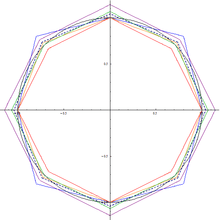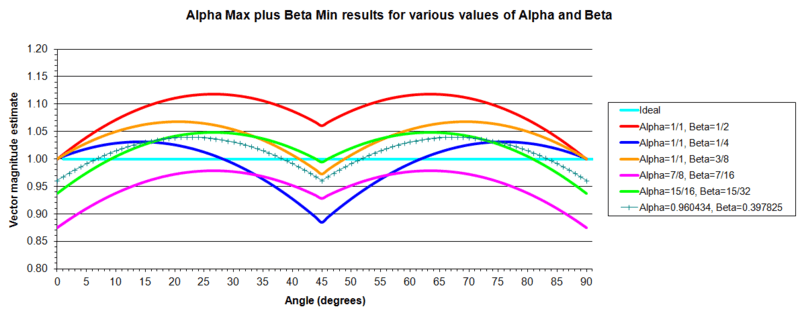Alpha max plus beta min algorithm

The alpha max plus beta min algorithm is a high-speed approximation of the square root of the sum of two squares. The square root of the sum of two squares, also known as Pythagorean addition, is a useful function, because it finds the hypotenuse of a right triangle given the two side lengths, the norm of a 2-D vector, or the magnitude of a complex number z=a+bi given the real and imaginary parts.
The algorithm avoids performing the square and square-root operations, instead using simple operations such as comparison, multiplication, and addition. Some choices of the α and β parameters of the algorithm allow the multiplication operation to be reduced to a simple shift of binary digits that is particularly well suited to implementation in high-speed digital circuitry.
The approximation is expressed as:
Where is the maximum absolute value of a and b and is the minimum absolute value of a and b.
For the closest approximation, the optimum values for and are and , giving a maximum error of 3.96%.
| Largest error (%) | Mean error (%) | ||
|---|---|---|---|
| 1/1 | 1/2 | 11.80 | 8.68 |
| 1/1 | 1/4 | 11.61 | 3.20 |
| 1/1 | 3/8 | 6.80 | 4.25 |
| 7/8 | 7/16 | 12.50 | 4.91 |
| 15/16 | 15/32 | 6.25 | 3.08 |
| 3.96 | 2.41 | ||

See also
- Hypot, a precise function or algorithm that is also safe against overflow and underflow
References
- Lyons, Richard G. Understanding Digital Signal Processing, section 13.2. Prentice Hall, 2004 ISBN 0-13-108989-7.
- Griffin, Grant. DSP Trick: Magnitude Estimator.